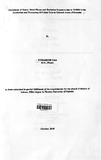Assessment of Heavy Metal Fluxes and Radiation Exposure due to NORM in the Extraction and Processing of Coltan Ores in Selected Areas of Rwanda
Abstract
The present study quantifies heavy metal fluxes and radiation exposure due to Naturally
Occurring Radioactive Materials (NORM) in the extraction and processing of the ColumbiteTantalite
(Coltan) mineral in Muhanga, Ruli and Ngoma areas of Rwanda. Heavy metal in
samples of Coltan ore, mine sediments and soil from the three areas were analyzed using the
Energy Dispersive X-Ray Fluorescence (EDXRF) spectrometry. Activity concentrations of
primordial radionuclides 4oK, 238U and 232Th in samples of Coltan, sediments and soil were
determined by Hyper Pure Germanium (HPGe)-based gamma-ray spectrometry. Multivariate
chemometrics techniques, Principal Component Analysis (PCA) and Hierarchical Cluster
Analysis (HCA) were used to explore the salient relationships among measured data (heavy
metals, radionuclides). The heavy metals were categorized into three classes which may be
interpreted as, elements normally associated with coltan; radioactive minerals; and heavy
metal toxic elements. Multivariate chemometrics techniques enabled to classify the samples
into three coltan types namely; processed coltan, extracted (or unprocessed) coltan, mine
sediments and control soil samples. Processed coltan is purified coltan which is obtained after
separating soil and coltan by using water. Extracted coltan is the raw ore taken immediately
from soil; it is a mixture of coltan and soil. Sediments are the wastes produced after removing
coltan. Control soil sample is the soil which was taken from an area within the vicinity but
outside the mining site. Coltan ore were also classified according to their origin using
principal component analysis (PCA).
The result of elemental analysis showed that the most abundant elements were Tantalum
(Ta), Niobium (Nb) and Tin (Sn). These elements are normally associated with Coltan. The
highest concentration of Ta (30.6 %), Nb (25.7 %) and Sn (16.4%) were observed in
processed Coltan. In some sediment samples Ta (35.6-63.3 ug gol)and Nb (35.4-83.8 ~g gol)
were also reported but at lower level. Heavy toxic elements such as lead (Pb), manganese
(Mn) and zinc (Zn) were also observed in all samples with manganese having the highest
concentration (35,155-65,200) ug g'l and lead having the lowest concentration (548-1655) ug
g'l, Radioactive elements (U, Th, K) were detected in all samples with the highest
u
concentration found in processed Coltan (115-569) ug g'\ (281-797) ug g'l and (15,87037,900)
ug g'l respectively.
The average activity concentration of238U (513 Bq kg'l) and 232Th(57 Bq kg") in all sample
exceed the world wide average of238U (35Bq kg'l) and 232Th(30 Bq kg'\ while the average
40K (267 Bq kg") activity was below the world wide average of 400 Bq kg". Absorbed dose
was obtained by measurement and models of calculation. In general the measured absorbed
dose was found to be 2 times higher than the calculated absorbed dose. The measured
absorbed dose varied 507.43-845.71 nGy h" (average: 665.5 nGy h'I), whereas the calculated
absorbed doses varied 63.52-779.07nGy h'l (average: 286.19 nGy h'I). These values are 5-11
times higher than the world wide average absorbed dose reported by UNSCEAR which is 55
nGy h'l. This characterized the sampled areas of Rwanda as High Background Radiation
Area (HBRA). Among the exposure pathways considered, inhalation of Coltan bearing dust
resulted in the highest doses exposures from crushing and sieving Coltan in the mill;
estimated up to 0.53 mSv (98 per cent of the total exposure) per annum on average. Further
assessment of radiation exposure due to NORM should be carried out in the whole country
and consider not only coltan but also other minerals of economic importance
Citation
Master of Science (Physics)Publisher
University of Nairobi School of Physical Sciences

